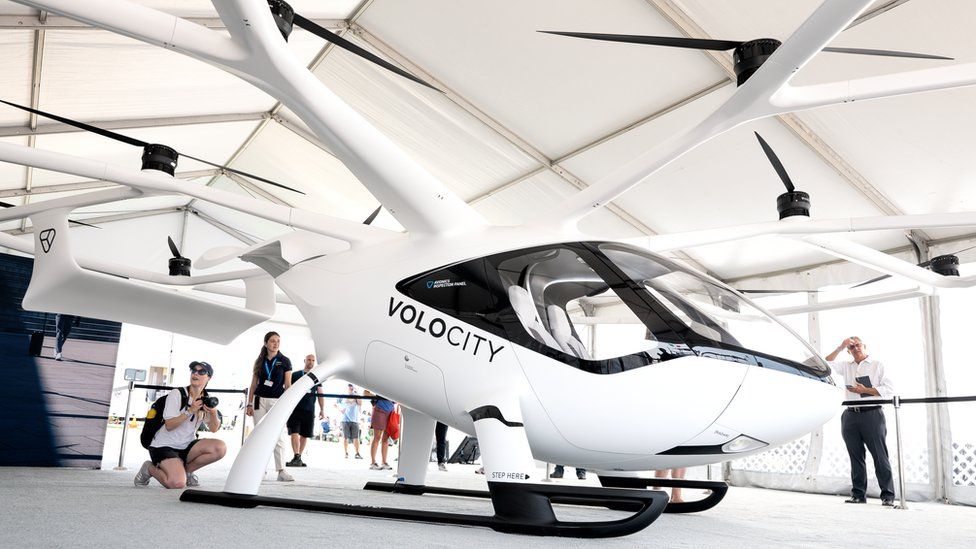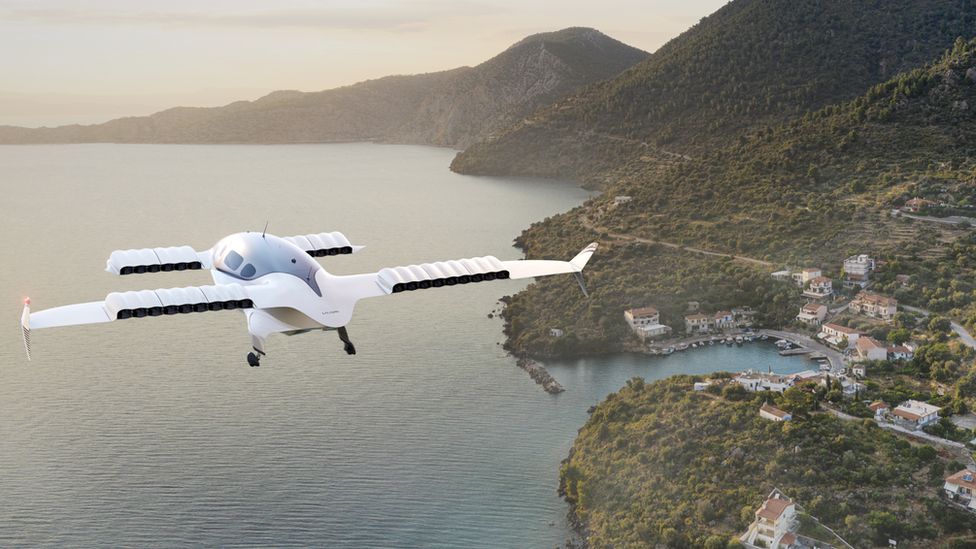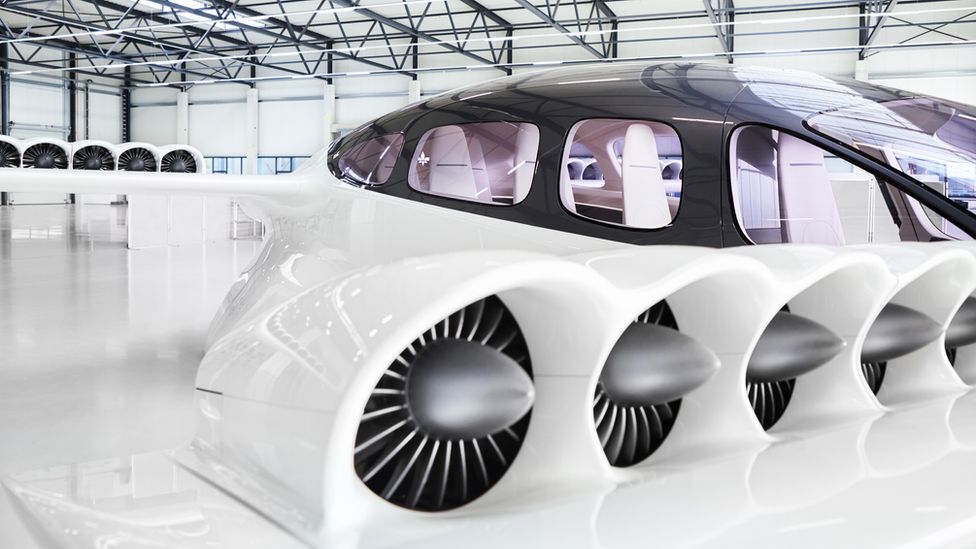Will electric flying taxis live up to their promise?
This video can not be played
To play this video you need to enable JavaScript in your browser.
In a year’s time the Summer Olympics will be underway in Paris.
The athletes will, of course, be hoping to make history, but so will one aviation start-up, Volocopter.
If all goes to plan, its two-seater electric aircraft, VoloCity, will be carrying passengers around Paris. It will be the first service in Europe to use an electric vertical take-off and landing (EVTOL) aircraft.
Dozens of companies around the world have been developing EVTOL aircraft, promising quieter, cheaper and emission-free aircraft, that can land right in the heart of cities.
Volocopter expects to get the European aerospace regulator, EASA, to clear its machine, the VoloCity to carry passengers in the next few months, so they can be ready for the Olympics.
“Everything is ready and set to go for the middle of next year,” says Christian Bauer, the German company’s chief financial officer.
Three routes will connect the centre of Paris with the city’s airports and heliport. Volocopter will also offer round trips for sightseeing.

Much work has gone into organising flight paths and landing spots (called vertiports) – not easy in a crowded city like Paris. Add to that the technical challenge of developing, and getting certification for, a new aircraft and it’s clear Volocopter has achieved a lot in its 12-year history.
But some would argue that the biggest challenges lie ahead for Volocopter and its rivals. In the coming years they will need to show that there is a market for their aircraft.
Batteries remain the biggest problem. They remain heavy and expensive, which curtails the range and limits the cost advantages of EVTOL aircraft, over helicopters, trains and cars.
The VoloCity has a range of 22 miles, which is enough for short city hops, but is not very far compared to the range of a helicopter.
Mr Bauer acknowledges the challenge: “What is hindering us is right now the battery technology, which all the peers are right now working on.”
He says that more powerful, cheaper batteries will emerge, allowing Volocopter to build a bigger aircraft that will be able to offer services at lower prices.
“We will be starting with more premium prices at around a helicopter segment pricing. And then we will gradually go down, with a big step, when we have a four-or-five seater model in place,” he says.

Lilium, also based in Germany, has already developed a larger EVTOL. Designed to carry up to six passengers, it is an elegant looking machine.
Rather than using rotors like Volocopter, Lilium uses 30 electric jets that can be tilted in unison to swing between vertical lift and forward flight. It expects to get certification from EASA in 2025.
Lilium says there is potentially a huge market for such an aircraft which can offer connections around congested cities, or services where rail links are poor.
“Where you have a good train connection at low cost… we wouldn’t want to compete with it. We come into play when there is no infrastructure and infrastructure is difficult to build,” says Lilium chief executive Klaus Roewe.
He points to a deal announced in June under which Shenzhen Eastern General Aviation (Heli-Eastern), plans to buy 100 Lilium aircraft.
Heli-Eastern runs air links in the Greater Bay region of China, which includes Hong Kong, Shenzhen and Macao. With mountains, many islands and peninsulas it can be a “nightmare” to get around, says Mr Roewe.

But like Volocopter, Lilium is banking on improving battery technology to make its aircraft competitive.
Mr Roewe says there remains “uncertainty” over the costs of batteries, but he believes prices will go down and capacity will go up. He thinks the EVTOL industry can piggyback on the advances made in batteries for cars.
“There is no reason why our batteries should be more expensive than any automotive battery, because the production process is exactly the same,” says Mr Roewe.
Despite that optimism, some experts are sceptical about the expectations of the EVTOL industry when it comes to batteries.
“They [EVTOL aircraft] actually have a very special battery set, that’s a very low production and very expensive production, and will not reach high volumes any time soon,” says Bjorn Fehrm who has a background in aeronautical engineering and piloted combat jets for the Swedish Air Force. He now works for aerospace consultancy Leeham.
Mr Fehrm points out that, to take off and fly, EVTOL aircraft draw power from the battery much more quickly, than a car does from its battery.
Also, to be economic, the aircraft would need to be charged quickly. The quick charge and discharge puts a heavy toll on the battery, requiring a different and more expensive system than that of a car, Mr Fehrm says.
He does see future improvement, but probably batteries only “twice” as good by the end of this decade.


Mr Fehrm says the present lack of battery capacity limits the conditions that EVTOL aircraft can fly in. For example, a helicopter is likely to have the range to fly around a storm, EVTOL aircraft with a much more limited range, would not be able to do that.
As well as improving the battery technology, the new EVTOL firms will have to set up factories to produce their aircraft in greater numbers.
That’s likely to be an expensive process, as EVTOL aircraft use the same processes as the aircraft industry which are not suitable for low-cost, high-rate production, according to Mr Fehrm.
Darrell Swanson, an aviation consultant who specialises in electric aviation, agrees that battery technology rollout is “a challenging process but it is accelerating”.
He also makes the point that the new firms will have to get much bigger: “It is crucial for the industry to scale-up to avoid adopting a model limited to business travellers or financially privileged individuals.”
In April, Volocopter opened its first assembly line in Bruchsal, near Stuttgart in southern Germany, capable of producing 50 aircraft a year, but it hopes by the end of the decade to be producing between 5,000 and 7,000 aircraft every year.
Mr Bauer acknowledges that there is much work and investment to be done.
“I would say we are at the last step of the first marathon to certify that vehicle. So then the next marathon begins – to get to profitability.”

